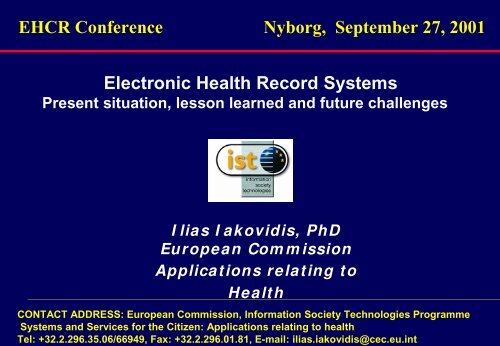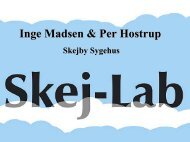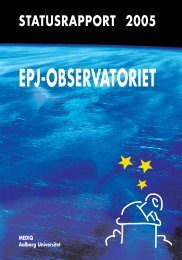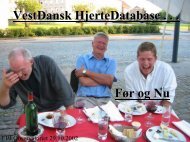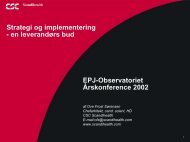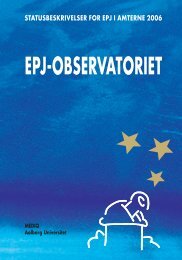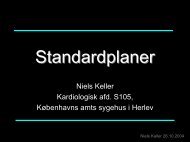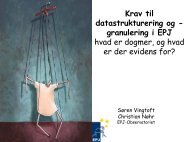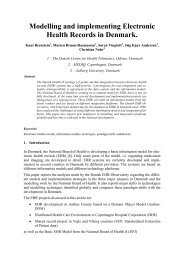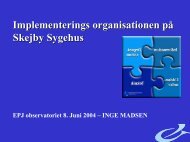Electronic Health Record Systems EHCR ... - EPJ-Observatoriet
Electronic Health Record Systems EHCR ... - EPJ-Observatoriet
Electronic Health Record Systems EHCR ... - EPJ-Observatoriet
- No tags were found...
You also want an ePaper? Increase the reach of your titles
YUMPU automatically turns print PDFs into web optimized ePapers that Google loves.
EUROPEAN COMMISSIONResearch and Development (R&D) Programs88-90: AIM I- Advanced Informatics in Medicine - (20 Mil. EURO)91-94: AIM II 50 R&D projects (108 Mil. EUR)94-98: Telematics Applications for <strong>Health</strong> (135 Mil. EUR)130 R&D PROJECTS1300 Research Inst., Industries, User Associations, Public Authorities7000 EU Citizens involved99-02 Information Society Technologies relating to <strong>Health</strong>75 new projects (200 Mil. EURO)www.cordis.lu/ist/ka1/health/home.html
The <strong>Electronic</strong> <strong>Health</strong> <strong>Record</strong> -EHRDigitally stored (subset of the)healthcare record about individual’slifetime with a purpose to support thecontinuity of care (quality, access,efficiency), education, and research.The <strong>Electronic</strong> <strong>Health</strong> <strong>Record</strong> System -information systems that manages andoperates on the EHR. Helps to access andshare information to qualified persons inuser-friendly manner. Meets the securityrequirements to ensure confidentiality ofdata.
<strong>Electronic</strong>Computer-basedMedical <strong>Record</strong><strong>Electronic</strong>Computer-based<strong>Health</strong>Patient<strong>Record</strong>Personal <strong>Health</strong> <strong>Record</strong>
Percentage of Physicians having Computer in their practiceEurobarometer (June 2001)12010080%6040200AT BE DE DK ES FI FR GR IRL IT L NL PT SE UK EUCountries
Online medical practices using different categories of web content100%90%80%70%60%50%40%30%20%10%0%B DK D EL E F IRL I L NL A P FIN S UK EUaccessing HC professional websites prescribing information continuing education consulting medical journalsSource: Eurobarometer June 2001
Usage of Internet EU AveragesConsult professional databases 73%Consult doctor-to-doctor information 70%Search clinical cases 57%Consult (official) guidelines 50%Searching for new drugs 29%Receiving analyses results 27%Consult alternative treatment sites 23%Transfer administrative data 15%Transfer patient data 19%Interacting with patients 12% 30+%Eurobarometer 2000 2001
Current situation in EU hospitals= 100% Patient Administration <strong>Systems</strong>Hospital administrationPharmacy50 - 80% Laboratory Information SystemRadiology Information SystemDifferent medical applications(operation theater, nursing systems, ...)< 50% Clinical Patient <strong>Record</strong>Management Information <strong>Systems</strong>* IT investments by European hospitals =1,2% of budget (2,5% in the USA)Deloitte&Touchestudy:study: www.cordis.lu/ist/ka1/health/home.html
Towards wider implementation of <strong>EHCR</strong> systems1. Organizational, cultural2. National/regional strategies
Some examples of national/regional strategies<strong>Electronic</strong> Reimbursement / Billing(DK, FR, NL,SE, UK, SLO)Patient and professional cards( ES, FR, IT, DE, IRL)EC Projects: CARDLINK, DIABCARDNational / Regional healthcare networks(DK, FI, ISL, UK, SLO)Home care and telemedicine services(FI, GR, NO)
Towards wider implementation of <strong>EHCR</strong> systems1. Organizational, cultural issue2. National/regional strategies s3. Industrial issues
<strong>Health</strong> telematics industry• Unclear economic model - HC is not a ‘free market’(heavily regulated (public) market, large size-low profit sector)• Fragmented “local” market - mobility (export) restrictionslanguage, legal, cultural factors• Lack of industry lead standardizationCEN standards not necessarily adopted• Providers not willing to collaborate - no “Shopping guide”
Towards wider implementation of <strong>EHCR</strong> systems1. Organizational, cultural2. National/regional strategies3. Industrial issues4. Legal, ethical
European Council and Parliament directives• 95/46/EC on the processing of personal data and freemovement of such data to be implemented 24/10/98• 96/9/EC on the Legal Protection of Databases• 97/66/EC - concerning the Processing of personal Data and theprotection of Privacy in the Telecommunication Sector• Council of Europe recommendation on the protection ofmedical data (NoR.(97)5) Adopted 13/2/97• New EC Committee on ethical issues -info-ethicsContact Person: Petra Wilson, Petra.Wilson@cec.eu.int
Towards wider implementation of <strong>EHCR</strong> systems1. Organisational, cultural2. National/regional strategies3. Industrial issues4. Legal - confidentiality and security of data5. Technological, StandardisationInteroperability, Security, Terminology, Architecture, ...www.cordis.lu/ist/ka1/health/home.html)
applicationengineformatGEHR/CENKONA...architecture<strong>Health</strong> Data Management PartnersBrussels
applicationengineformatarchitecture<strong>Health</strong> Data Management PartnersBrussels
EHR Projects of the European Commission<strong>Electronic</strong> <strong>Health</strong> <strong>Record</strong>s Projects: >50 Mil. EURO EC contributionGALEN, SYNAPSES, SYNEX, I4C, HANSA,GEHR, PROREC, <strong>EHCR</strong>-SUPA, TOMELOTELENURSEwww.ehto.org, www.cordis.luEuropean Standardization OrganizationCEN TC251 http://www.centc251.org/Working Group I: Information Models (prENV 13606-1)Working Group II: Terminology and Knowledge BasesWorking Group III: Security, Safety and Quality
The Synex Project FrameworkInternet browser(e.g. Explorer)User applicationsGP• Requests / Booking• ResultsInternet……..……..……..………….Radiology………….ManagementMiddleware of common servicesSecurityWardsSynapsesFHCRI4CCardiology HCRGALENTerminologyTELENURSENursing systemDHEcommon dataSynEx frameworkBitways (technological platform & services)
Towards wider implementation of <strong>EHCR</strong> systems1. Organizational, cultural2. National / regional strategies3. Industrial issues4. Legal - confidentiality and security of data5. Technology and standards6. User acceptance
Example : <strong>Health</strong> ProfessionalsAcceptance Challenges• Difficult to use at the point of need- need to go to “computer” room- portable devices either very limited (small)or very heavy non-practical• Non- friendly Human-Computer Interaction- more natural access procedures (speech, mobile access)- presentation of recorded data, input output devicestop 3 priorities in interaction: speed speed speed
Data entry/output “The Bottleneck”•First there was a free textDo physicians read many pages of accumulated free text?•Then there was computer driven menudifficulties of expressing the reality•Now is the time for Intuitive, fast, and reliable waysof interacting- new interfaces and input devices- more reliable speech recognition(95% accuracy is not sufficient!)- natural language processing & understanding
zimolong@hia.rwth-aachen.de, www.hia.rwth-aachen.deInput Devices for Intraoperative PlanningTouchpadMost promising inputdevices of a group of 15different input devicesbased on literature reviewMouseTouchscreen with penAndreas Zimolong, Helmholtz-Institut fürBiomedizinische Technik an der RWTH-Aachen
Evaluation Criteria and MeasurementsCriterion• Learnability:• Efficiency:• User-satisfaction:• Workload:Andreas Zimolong, Helmholtz-Institut fürBiomedizinische Technik an der RWTH-AachenMeasures• Time needed for the task vs.number of steps needed forimprovement• Index of difficulty(according to Fitts Law) vs.time needed• subjective comparison ofinput devices, ISO 9241questionnaire• comparison of devices byZEISS scale, ISO 9241questionnaire
Results: Subjective Rating by ISO 9241 Questionnaireposture workloadsatisfactionneckshoulderarmwristfingerTouchpadMouseTouchscreenspeedaccuracyeffortuniformitynegativpositivAndreas Zimolong, Helmholtz-Institut fürBiomedizinische Technik an der RWTH-Aachen
Andreas Zimolong, Helmholtz-Institut fürBiomedizinische Technik an der RWTH-AachenConclusionsUsing a touchscreen allows for highest efficiency andrequires the less learning effortsTouchscreens are mostly preferred over other inputdevices and induce the smallest overall workloadThe use of a touchscreen for intraoperative interactiontasks involving manipulation of geometries in 2D is mostrecommendable.
Language EngineeringspeechspeechspeechrecognitionText To SpeechnaturallanguageunderstandingtexttexttextgenerationStructured representations of the textinformation processingcoding, translation, check for completeness, terminology update
DRIVING THE COMPUTERExample of Medical prescription“ 3 * 2 co Lasix 20 on Monday, Wednesday and Saturday one hourbefore the meal “Part 1 : adm-dose{f-a-unit} 3 {adm-num} 2 {adm-unit} coPart 2 : pn-spec{med-pn} lasix {med-ppd} 20Part 3 : t-spec-pat{day-sp-prep} on{dayname} Monday Wednesday Saturday{and}andPart 4 : med-meals{rm-prep-spec} 1 {rm-prep-unit} hour{rm-prep-pre} before {rm-pre-meal} the mealL&C www.landc.be
Wish list! Improving efficiency of search engine! Building query engine (based on concepts) for endusers,physicians and internal use! Automating index mechanism and topic assignment! Making a consistent index and topic list! Building a formal terminology system! Opening towards other languagesSuccess criteria: scalability, performance and time.
Benefits medical language understanding• Clinical coding as a (semi-)automatic by-product ofclinical registration• Compatibility of current interface with voice input• Consistent terminology management over users in acenter, and even amongst centers• contextual spell checking content analysis– patient selection in clinical trials– generation of alerts– summary of large documents
Example : <strong>Health</strong> ProfessionalsAre <strong>Health</strong> Telematics systems accepted and beneficial?BMJ vol. 22, Feb. 3rd 2001: 5475 articles searched from1980 -1997 on computer use in primary care setting ..only 67 scientific “clinical trial” studies!Which of the below processes have been found acceptableConsultation processPerformance of preventive tasksDisease managementPrescribingNoYesYesYes
Towards wider implementation of HT systems & servicesSOME LESSONS LEARNED
Lesson 1. Ensure well thought-out strategy• It is more about information management than IT• Get external experienced help!• Need to understand the issues related to- terminology, architecture, patient index- integration, security, performance- organizational issues, cultural issues- legal issues, human issues, ...• Many experts in Europe
Lesson 2: Break the pattern of large scaleall at once implementations• Stepwise approach more effectiveI. overcome the fear of usersII. <strong>Systems</strong> that improve the existing work processesIII. <strong>Systems</strong> that require re-engineering of processesFollow closely the work of CEN, HL7/XML, CORBA MED
Lesson 3: Keep it up… do not just set it up• Product vs serviceIt is more about service of what information you need whereand how fast instead of which computer to buy• The time window of available budgets are too short. Longterm commitment needed for installation phase and running ofthe system
Open sourceOpen Source is an Intellectual Property Right model for boththe developer and the user & software development modelOpen Source = Free Software = Libre SoftwareOpen Source is not freeware, shareware• SPIRIT - http://www.euspirit.org (Inventory and dissemination)The point of view of a MD:D. Carnall, Medical software's free future, BMJ, Oct 2000http://www.bmj.com/cgi/content/full/321/7267/976Contact point: Yves.paindaveine@c3ec.eu.int
Lesson 4: Ensure commitment of the “leaders”•There is a vulnerable moment in all implementations shortlyafter installation (phase of disillusionment) where thesuccess depends on “opinion leaders”• Involve the leaders, keep the management and theauthorities committedCOMMITMENT = INVOLVEMENT = COMMITMENT
Lesson 5: Ensure (legal and ethical) compliance•There is a lot of legal “grey area” around “paperlessenvironments”• Legal points relating to confidentiality and securityare the best excuse to boycott the system• Seek some accreditation scheme
Lesson 6: None of the parties can do it alone!•There is still lots of mistrusts and misunderstanding betweenindustry, users and decision makers• Necessary condition: Joint “venture” of authorities, users.industry• Examples: MEDCOM, Greek <strong>Health</strong> Telematics Forum, ...• EHTEL www.ehtel.org• PROREC - <strong>Electronic</strong> <strong>Health</strong>care <strong>Record</strong> Centerswww.sadiel.es/europa/prorec, www.prorec-france.fr
Topics considered in the presentation1. Present situation in EU2. Major obstacles in wider implementation3. Latest technologies pertaining to user friendliness4. Lessons learned from <strong>EHCR</strong> implementation around EU5. NEXT Call for proposals & Future challenges for EC?
Summary! <strong>EHCR</strong> Situation - very good in EU (especially north)! Many Lessons learned - but can we learn from othersmistakes?! Next challenge- make the systems USER FRIENDLY! many experts in EU - take advantage !!Are you proving benefits?! Ultimate goal - personal health records..Are we really ready for such a major restructuring?
ReferencesIakovidis I, Learning from past mistakes, European Conference on EHR (EUROREC’99),pp. 4-9, 1999Iakovidis I., Towards Personal <strong>Health</strong> <strong>Record</strong> " International Journal of MedicalInformatics, vol 52, No 123, pp. 105 –117 (1998).Iakovidis I., Pattichis C.C., Schizas Ch. N., Editorial article -Special issue on Emerging<strong>Health</strong> Applications in Europe, IEEE Transactions on Information Technology inBiomedicine, Vol 2, no 3, pp. 110-116, (1998).E Andrew Balas, Iakovidis I., Distance technologies for patient monitoring, British MedicalJournal, BMJ 1999; 319:1309, http://www.bmj.com/cgi/content/full/319/7220/1309Iakovidis I., User Acceptance in <strong>Health</strong> Telematics: an HCI perspective, Int. Conf. onHuman Computer Interaction (HCII ’99), Munich, Germany, Lawrence ErlbaumAssociates, Publishers 1999, pp. 863-867Iakovidis I, Towards a <strong>Health</strong> Telematics Infrastructure in the European Union, InInformation technology strategies from US and the European Union: Transferring researchto practice for health care improvement, IOS press, 2000 pp. 23-33


